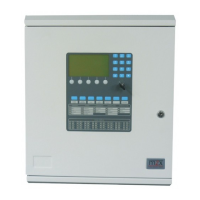MX/MZX
17A-04-S
17 10/09
PAGE 4 of 40
2. ROUTINE CHECKS
2.1 GENERAL
The checks described in the following paragraphs would
normally be carried out at the intervals stated. The Detector
Condition Monitoring facility checks the condition of 800
series smoke detectors and will signal a fault when a smoke
detector reaches the limit of its compensation.
Therefore, if a controller has detector condition monitoring,
the following procedure should be carried out:
a) At regular intervals, or when a detector
condition monitoring fault is generated,
obtain a printout of all points out of
compensation (see section 3.13.2.2).
b) From the data obtained, replace only those
detectors which are out of compensation.
For Marine Systems carry out routine checks in accordance
with the customer’s own procedures.
2.2 WEEKLY CHECKS
These checks would normally be carried out by a
responsible member of the customer’s staff. They should
also be carried out by the service engineer after all routine
maintenance checks:
WARNING:
WARN ALL PERSONNEL THAT THE
SOUNDERS ARE ABOUT TO BE TESTED.
Proceed as follows:
a) If necessary, clean the front panel of the
controller with a suitable cleansing agent.
b) Check all batteries in accordance with
publication 05A-10-S1.
c) Service Engineer only - Check the
tightness of all terminal block screws inside
the controller.
d) Using the walk test function (see sections
3.13.1), check the operation of at least one
zone. If a printer is available, print out the
results of the walk test (see section 3.12.2).
e) Set one device (either a callpoint or detector)
from one zone into alarm and check that the
system responds as follows:
• The controller’s internal buzzer sounds in
a continuous tone.
• The two red ‘FIRE’ LEDs on the
controller front panel light.
• The appropriate red ‘FIRE ZONAL’ LED
(if configured) flashes.
• The general and zonal sounders operate.
• The alphanumeric display gives the
location of the alarm.
f) Record the device used to initiate the test in
the site log book and reset the controller.
g) Check the condition of the printout on any
printers attached to the system and replace
the ribbon if it is becoming faint.
h) Ensure that each printer has an adequate
supply of paper.
Any defect should be recorded in the log book and
appropriate action taken. On completion of the work,
obtain the signature of the customer or his representative for
the Routine Maintenance Visit Record. Leave a copy of
this record with the customer for his files.
2.3 THREE-MONTHLY CHECKS
Proceed as follows:
a) Perform the weekly checks as detailed in
section 2.2.
b) Check the entries in the log book and carry
out any necessary action.
c) Check the batteries and their connections in
accordance with publication 05A-10-S1.
d) Check all the ancillary functions of the
controller.
e) Check all fault indicators by simulating a
FAULT condition in each zone by either:
i) removing a detector from its base, or;
ii) disconnecting the local circuit from an
ancillary unit, or;
iii) removing the end-of-line resistor from an
ancillary unit’s circuit.
f) Visually check the condition of the
controller and other ancillary equipment for
signs of moisture ingress and other
deterioration.
g) Visually check the installation to ascertain
whether structural or occupancy changes
have affected the requirements for the siting
of manual callpoints, detectors, line isolator
base, sounders or sounder bases.

